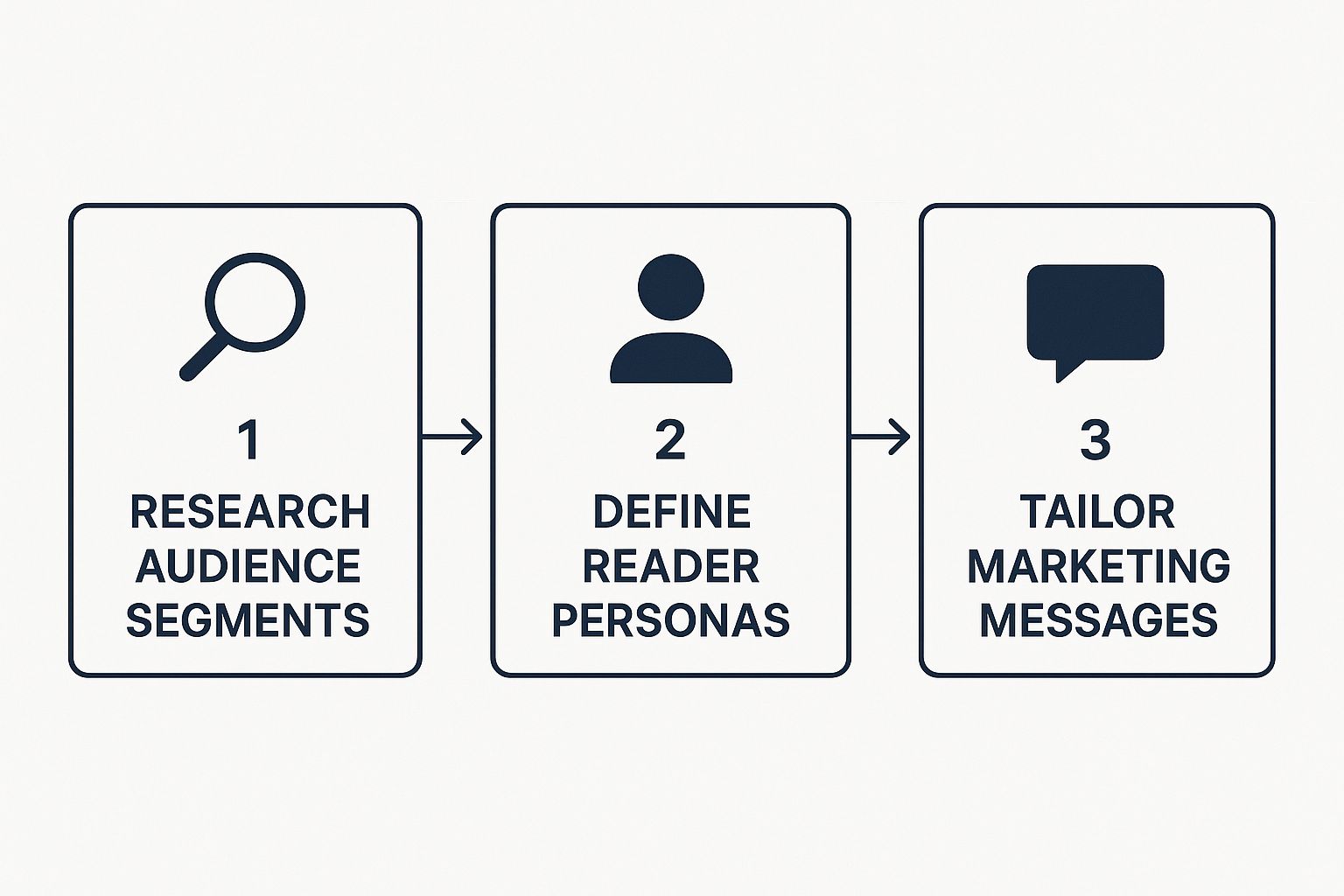Think of your book launch like a movie premiere. The red carpet, the flashing lights, the buzz—it doesn't just happen. It’s the result of months of careful planning, teasing trailers, and building anticipation. A successful book launch works the same way. It all starts with a solid pre-launch blueprint designed to build a crowd of eager readers before your book even hits the shelves.
This isn't about a last-minute scramble to sell copies. It's about methodically building a community around your work, turning marketing into a series of genuine conversations with people who can't wait to read what you've written.
Pinpoint Your Ideal Reader
Before you write a single social media post or send one email, you have to know exactly who you're talking to. And I mean exactly. "Women aged 30-50 who like fantasy" is far too broad.
Let's get specific. What other authors do they obsess over? Are they binging The Witcher or rewatching Bridgerton? Do they hang out in niche subreddits or dedicated Facebook groups?
I always tell authors to create a detailed reader persona. This is essentially a fictional character profile of your perfect reader. Give them a name, a job, maybe even a favorite coffee order. This persona becomes your compass. Every marketing decision, from the ad copy you write to the podcasts you pitch, should be made with this one person in mind.
Key Takeaway: When you market to everyone, you connect with no one. A hyper-specific reader persona helps you craft messages that resonate so deeply, your ideal readers will feel like you wrote the book just for them.
The goal is to move from broad assumptions to specific, tailored communication that truly connects. This is a direct result of putting in the research upfront.

As you can see, understanding your audience is the foundation for creating messages that actually work.
Establish Your Author Hub
In a world of ever-changing social media algorithms, your author website is your piece of digital real estate. It's the one place online that you own and control completely. This is your professional home base where new readers can discover you and existing fans can connect.
Your site doesn't need to be fancy, but it absolutely must have a few non-negotiables:
- An engaging "About Me" page: Tell your story and let your personality shine.
- A dedicated book page: Show off your cover, share the blurb, and provide clear buy links.
- A blog or updates section: Share behind-the-scenes content, writing updates, or related articles to keep people coming back.
- A can't-miss email sign-up form: Make it easy and inviting for people to join your list.
That email list is, without a doubt, your single most powerful marketing tool. These aren't just followers; they are your core supporters who have literally raised their hands and asked to hear from you. Treat them like gold. Send them exclusive content, cover reveals, and early news. They'll be your first buyers and your loudest cheerleaders on launch day.
The global book market was valued at over $150 billion in 2022, and carving out your slice requires a smart strategy. With self-publishing costs ranging from $2,000 for editing to $7,000 for translation, having a direct line to your readers through an email list isn't just nice—it's essential for a positive return on your investment. For more data, you can discover more fiction book sales statistics and insights on fromwhisperstoroars.com.
To help you stay on track, I've put together a simple checklist of the key activities to focus on before your book goes live.
Pre-Launch Promotion Checklist
This table breaks down the core promotional tasks to tackle in the months leading up to your launch. Think of it as your roadmap to building momentum.
| Activity | Key Objective | Timeline |
|---|---|---|
| Finalize Reader Persona | Define your target audience for all marketing efforts. | 6+ months pre-launch |
| Set Up Author Website | Create a central hub for all your author activity. | 5-6 months pre-launch |
| Start Your Email List | Begin collecting emails with a compelling lead magnet. | 4-5 months pre-launch |
| Plan Social Media Content | Create a content calendar with teasers, reveals, and countdowns. | 3-4 months pre-launch |
| Reach Out to Influencers | Identify and contact reviewers, bloggers, and bookstagrammers. | 3 months pre-launch |
| Secure Early Reviews | Send out Advance Reader Copies (ARCs) to your street team and influencers. | 2-3 months pre-launch |
| Schedule a Cover Reveal | Build excitement and anticipation with a coordinated reveal event. | 1-2 months pre-launch |
Completing these steps will put you in a fantastic position, transforming your launch day from a hopeful wish into a well-orchestrated event with an audience ready to celebrate (and buy!) your new book.
Mastering Your Digital Bookshelf

With your pre-launch work in place, it’s time to shift focus to where readers will actually buy your book. I’m talking about your digital bookshelf—the online pages on Amazon, Goodreads, and other retailers that act as your virtual storefront. This isn't just a simple listing; it's your most powerful sales tool.
Think of it this way: a poorly managed Amazon page is like a bookstore with peeling paint and a flickering "Open" sign. It doesn't inspire confidence. On the other hand, a sharp, well-crafted page invites readers in and makes them want to stay.
Crafting a Book Description That Actually Sells
Let's be blunt: your book description is your sales pitch. It's the digital equivalent of the back cover, and its only job is to turn a casual browser into an eager reader. A generic summary just won't do the trick. You have to grab them from the very first sentence.
Start with a hook—a provocative question or a bold statement that resonates with your target audience. If you've written a thriller, you could open with something like, "How far would you go to protect a secret that could destroy everyone you love?" For a romance, maybe it’s, "She was the one person he could never have… until now." This instantly sets the mood and pulls the reader in.
From there, introduce the core conflict and what’s at stake, but don't you dare give away the plot. Use short, punchy paragraphs and language that paints a picture. And always, always end with a cliffhanger or a powerful promise of what the reader will feel. You aren’t just selling a story; you’re selling an experience.
My favorite trick: Use simple HTML tags like
<b>for bolding and<i>for italics right inside your Amazon description. This is a game-changer for making key phrases stand out. It breaks up that wall of text and makes your page far easier for skimmers to digest.
The numbers back this up. The ebook market is projected to reach $14.9 billion in 2025, and online retailers command a staggering 54% of that market. This means platforms like Amazon aren't just an option; they're essential.
The Art of Choosing Keywords and Categories
Think of keywords as the secret trails that lead readers directly to your book. On platforms like Amazon KDP, you get to choose up to seven. My advice? Don't waste them on generic terms like "fantasy" or "mystery." You have to get inside your reader's head. What specific things are they actually typing into that search bar?
Here’s what I mean:
- Go long-tail: Instead of just "romance," try something specific like "enemies to lovers office romance."
- Use comp titles: Don't be shy about using phrases like "for fans of Sarah J. Maas" or "a thriller in the vein of The Silent Patient."
- Lean into tropes: Readers search for what they love. Include terms like "found family trope" or "morally grey hero."
Categories are just as important. You need to drill down as deep as you possibly can. Don't just settle for "Fiction > Fantasy." Push further to "Fiction > Fantasy > Epic." The more niche your categories, the less crowded the field. This gives you a much better shot at hitting a bestseller tag, which is one of the most powerful, yet overlooked, https://barkerbooks.com/book-promotion-ideas/ you can use.
Ultimately, getting your digital bookshelf right is about making sure readers can find you. It helps to understand the mechanics behind it all, and this guide to how search engine indexing works offers some fantastic insights into how that discovery process functions.
Connecting With Readers On Social Media
Social media is the modern-day equivalent of word-of-mouth, but let’s be honest: just dropping “buy my book” links into the void doesn't work. Readers are looking for a connection, not a constant sales pitch. To really move the needle, you have to stop thinking of your social media profiles as billboards and start treating them like community hubs.
This means a fundamental shift in your approach. Instead of just selling a product, you’re inviting people into your world and sharing your journey. Give them a reason to follow you that has nothing to do with your book's launch day. When you show them the real, messy, human side of being an author, you build a bond that turns a passive follower into a true fan—someone who is genuinely invested in your success.
Finding Your Platform And Voice
First things first: you don’t need to be everywhere. It’s a classic rookie mistake. Spreading yourself thin across five different platforms is a recipe for burnout. It's so much more effective to go deep on one or two channels where your readers actually spend their time.
Think about your audience. Where do they gather? If you write thrillers, you might find your people on X (formerly Twitter), where discussions are fast and furious. If you’re in romance or fantasy, the massive #BookTok and #Bookstagram communities on TikTok and Instagram are probably your best bet.
Once you know where to post, you need a plan for what to post. Your content should reflect your unique author brand. Here are a few ideas I've seen work wonders for building real engagement:
- Behind-the-Scenes Content: Post a picture of your chaotic writing desk, share a fascinating (but spoiler-free!) tidbit from your research, or even just vent about the struggle of hitting your word count. It makes you relatable.
- Character Deep Dives: Try a live Q&A where you answer questions in character. Post an "ask me anything" about your protagonist's deepest fears or your villain's secret soft spot. It gets readers invested in your fictional world.
- Interactive Posts: Run a simple poll asking your followers to name a coffee shop in your book or vote on a minor character's fate. This gives them a small sense of ownership and makes them feel like part of the creative process.
Creating Community Around Your Work
Ultimately, your goal is to foster a community that talks with you, not one you just talk at. This means getting into the trenches—reply to comments, celebrate fan art when you see it, and share photos from readers who've bought your book. Make your followers feel seen. That kind of loyalty can't be bought with ad dollars.
Building these genuine relationships is at the very heart of what it means to be a modern author. If you want to dive deeper into strategies for specific platforms, our guide on social media for authors has more targeted advice.
The most powerful promotion happens when a reader feels like they've discovered a hidden gem and can't wait to tell their friends. Your job on social media is to create the perfect environment for that discovery.
Once you’ve built that organic foundation, you can think about putting some money behind your efforts to reach new people. Paid advertising is a powerful tool for amplifying your message. Using targeted platforms like Facebook Ads lets you find readers based on the authors and genres they already love, turning your community-building efforts into a scalable strategy for growth.
8. Build Your Author Alliance

Trying to promote a book all by yourself is a lonely, uphill battle. I’ve seen countless authors burn out trying to do it all. The smartest authors I know have all learned the same secret: marketing is a team sport.
It’s all about building an alliance of supporters—fellow authors, dedicated readers, influential bloggers—who can help you spread the word. This isn’t about cold-calling for favors. It’s about creating real, symbiotic relationships that benefit everyone involved. A single shout-out from a trusted book blogger can create a bigger sales spike than a week's worth of your own frantic posting.
Find and Connect With the Right Reviewers
Your first move should be identifying the key voices in your book's genre. Book bloggers and influencers on platforms like Instagram (#Bookstagram) and TikTok (#BookTok) command loyal audiences who hang on their every word. But you have to find the right ones.
Start by searching for blogs and accounts that cover books like yours. If you've poured your soul into a dark, gritty sci-fi epic, pitching it to a reviewer who only covers sweet, cozy romances is a waste of everyone's time. Look for reviewers whose audience demographics and tastes match your ideal reader.
Once you’ve curated a solid list, it's time to reach out. Please, don't send a generic, copy-pasted email blast. It’s the quickest way to get your message deleted. Personalization is everything.
- Do your homework. Mention a specific review of theirs you genuinely enjoyed. This small step proves you’re not just spamming a list.
- Keep your pitch sharp and to the point. State your book’s genre, a one-sentence hook, and its word count right away.
- Make their job easy. Attach your book cover and a short summary. Most importantly, offer the book in their preferred format, whether that’s a mobi file, an ePub, or even a physical copy.
A Quick Word of Advice: Never, ever ask for a positive review. You're requesting their honest, professional opinion. A reviewer's credibility is their currency, and they'll respect you for understanding that, even if your book isn't their cup of tea.
Assemble Your Street Team
Beyond professional reviewers, some of your most powerful allies are your own readers. This is where a street team comes in. Think of it as a small, hand-picked group of your biggest fans who get early access to your book. In return, they agree to champion it during the critical launch week.
These are the amazing people who will drop those crucial early reviews, post about your book on their social feeds, and personally recommend it to their friends. That initial burst of activity is gold—it creates social proof and signals to retailer algorithms that your book is worth paying attention to.
Invite your most active email subscribers or social followers to be part of this inner circle. Treat them like the marketing superstars they are, because that's exactly what they'll become. Building this support network is a key piece of the puzzle; for a complete picture of the entire publishing journey, you can explore our guide on how to become a published author.
Taking Your Book Global: How to Expand Your Reach to New Markets

Once your book has found a solid footing with its initial audience, it's easy to get comfortable. But if you’re looking for serious, long-term growth, the real opportunity often lies just over the horizon in markets you haven't even touched yet. Pushing your book into new regions and connecting with different reader groups is one of the most powerful moves you can make.
Don't let the idea of "going global" intimidate you. It often starts with small, smart moves. A great first step is to dig into your existing sales data. Are you noticing a surprising number of orders from places like Australia, the UK, or Germany? That’s not a fluke; it's a clear signal of untapped demand and a perfect place to focus your promotional efforts.
To really capitalize on that interest, paid advertising can be a game-changer. Pay-Per-Click (PPC) campaigns, for example, allow you to laser-target readers in specific countries with ads designed just for them. It’s a direct way to turn that flicker of international interest into actual sales. For a comprehensive look at how this works, this ultimate guide to PPC is an excellent resource.
Finding Your Next Big Market
When you're scouting for new readers, market data is your compass. While the U.S. book market shows steady growth, the most exciting developments are happening elsewhere. For example, the Asia Pacific region is forecast to see the highest growth rate from 2025 to 2030, a surge driven by a huge appetite for books in regional languages. This kind of data points to massive opportunities for authors who are ready to adapt.
This tells you one thing loud and clear: a one-size-fits-all strategy won’t cut it. To succeed abroad, you need to tailor your approach.
- Rethink Your Price: A price that feels normal in the United States could be a major barrier in another country. Adjust your pricing to match local economies.
- Mind the Culture: Your ad copy, cover art, and even your author photo need to resonate culturally. What works in North America might fall flat—or even offend—elsewhere.
- Go Where the Readers Are: Don't just stick to Amazon US and Facebook. Promote your book on the retail sites and social media platforms that are popular in your target country.
Key Insight: Simply making your book available worldwide isn't enough. You have to actively market it in a way that connects with local readers and fits their unique buying habits.
Diving Deeper with Translation and Audiobooks
If you're truly committed to breaking into a new market, translation is the final frontier. It's a significant investment, no doubt about it. But translating your book into a language like Spanish, German, or Mandarin can open the door to a massive, entirely new readership that you could never have reached otherwise.
And let's not forget the audiobook explosion. With global audiobook revenue climbing every year, creating an audio version of your book connects you with a completely different type of consumer. Think of the commuters, the gym-goers, the people who listen while doing chores.
Promoting an audiobook alongside your print and ebook versions creates a powerful trifecta. You’re maximizing your sales potential by meeting readers wherever they are, in whatever format they prefer.
Answering Your Biggest Book Promotion Questions
Let's be honest, figuring out how to market your book can feel just as daunting as writing it. You’ve poured your heart into the manuscript, and now you’re facing a whole new world of strategy and promotion. I get a lot of the same questions from authors, so let's tackle them head-on and clear up the confusion.
How Much Should I Actually Spend on Marketing?
This is the big one, isn't it? The truth is, there's no single right answer. I've seen authors hit bestseller lists with almost no budget, relying purely on hustle and smart organic marketing. I've also seen authors get fantastic results by investing strategically in ads.
Your budget really comes down to your personal goals and what you can comfortably afford. Don't feel pressured to spend thousands right out of the gate. A great way to start is by testing the waters with a small, manageable ad campaign. Try putting $50 or $100 toward Amazon Ads or Facebook Ads and watch the data closely. The most important thing is tracking your return—for every dollar you spend, are you earning it back in royalties? That data will tell you when it's time to scale up.
When Is the Right Time to Start Promoting My Book?
Ideally, you should have started yesterday. But since we don't have a time machine, the next best time is right now. Seriously. You want to start building momentum a good 3-6 months before your book even hits the shelves.
Think of this pre-launch window as your runway. It’s your chance to:
- Build an email list: This is your direct line to your most dedicated readers. They'll be the first ones to buy, review, and spread the word.
- Get early reviews: Start sending out Advance Reader Copies (ARCs) to your street team, influencers, and book bloggers. Social proof is everything on launch day.
- Generate buzz on social media: This is the fun part! Reveal your cover, post snippets and quotes, and do a countdown to build excitement.
Starting early is the difference between launching your book to a ready, waiting audience and just shouting into the digital void. You’re not just releasing a book; you’re orchestrating an event.
Should I Pay for Book Reviews?
Let me be crystal clear: no. Never, ever pay someone for a guaranteed positive review. It’s unethical, readers can smell a fake a mile away, and platforms like Amazon will penalize you for it, sometimes by removing your book entirely. It's just not worth the risk to your reputation.
Now, there’s a crucial distinction to make here. Paying for a review service is different. Reputable industry names like Kirkus Reviews or Foreword Clarion Reviews offer professional, unbiased critiques for a fee. These are legitimate editorial reviews, not purchased five-star ratings. They can lend your book a ton of credibility, but a positive outcome isn't guaranteed. Your best bet is to focus on building genuine relationships with readers and reviewers.
At BarkerBooks, we know that navigating the world of book promotion can be complex. We offer targeted advertising campaigns and social media marketing services designed to connect your book with the right readers. Let our expert team help you build a promotion strategy that delivers results. Learn more about how we can help.
